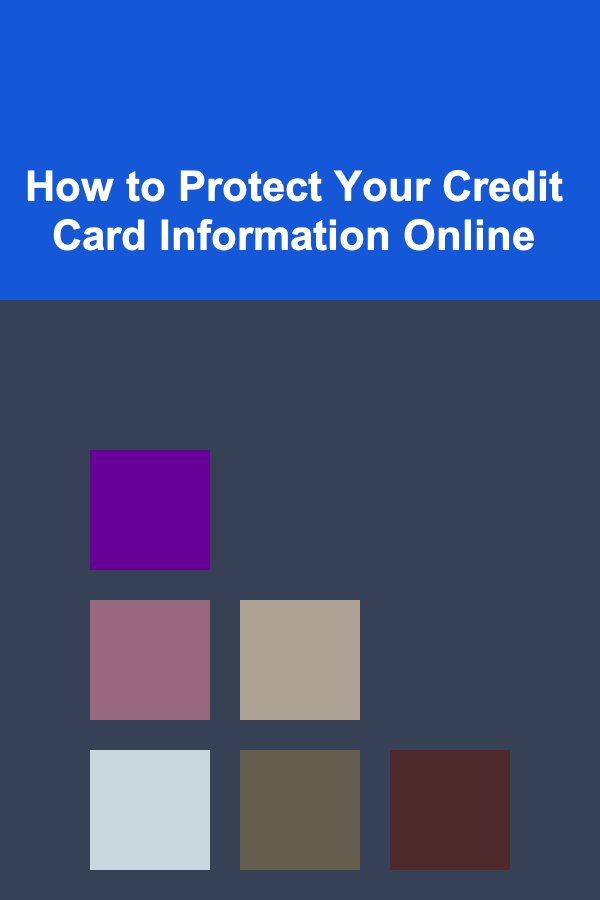
How to Protect Your Credit Card Information Online
ebook include PDF & Audio bundle (Micro Guide)
$12.99$11.99
Limited Time Offer! Order within the next:

In today's digital age, credit card information is more vulnerable than ever. Online shopping, banking, and various other digital transactions are part of our everyday lives, making credit card security a top priority. Whether you're buying groceries, booking a flight, or paying bills, your credit card information is constantly being shared across multiple platforms. As convenient as this may be, it also opens up opportunities for fraudsters and cybercriminals to steal your sensitive data.
Protecting your credit card information online is not just about being cautious during transactions; it involves a combination of proactive measures, vigilance, and security practices that extend across your digital interactions. This comprehensive guide aims to help you understand the risks, take preventive actions, and ensure that your credit card information remains safe and secure while navigating the online world.
Understanding the Risks to Your Credit Card Information
Before diving into how to protect your credit card information, it's important to understand the various ways your data could be compromised.
1.1 Phishing Attacks
Phishing is one of the most common and deceptive methods used by criminals to steal personal and financial information. Fraudsters often impersonate legitimate organizations---such as your bank or a popular retailer---by sending fraudulent emails, text messages, or even phone calls that appear authentic. These messages usually contain links or attachments that, when clicked, lead to fake websites that ask for your credit card details.
1.2 Data Breaches
Companies that store sensitive data, such as your credit card information, are at risk of data breaches. Hackers often target large retailers, financial institutions, and online service providers in order to access their databases. If they succeed, they can steal credit card information in bulk and use or sell it for fraudulent purposes.
1.3 Man-in-the-Middle Attacks
In this type of attack, cybercriminals intercept communications between you and a legitimate website or service. This often happens when you use public Wi-Fi or unencrypted websites to make transactions. The attacker "sits" between your computer and the website, capturing any sensitive information, including your credit card details.
1.4 Malware and Keylogging
Malware refers to malicious software designed to damage, disrupt, or gain unauthorized access to computer systems. Keyloggers are a type of malware that records every keystroke you make, including your credit card numbers and passwords. If your device becomes infected, your sensitive information can be transmitted to the cybercriminal without your knowledge.
1.5 Weak or Reused Passwords
Using weak, common, or reused passwords is a major vulnerability in protecting credit card information. Hackers can easily guess or use password-cracking tools to gain access to your online accounts. Once they gain access to your accounts, they can steal your credit card information or use your credentials for unauthorized transactions.
Best Practices to Protect Your Credit Card Information
Now that we understand the risks, let's look at the best practices you can follow to secure your credit card information online.
2.1 Use Strong, Unique Passwords
The foundation of online security begins with your passwords. A strong password is one that is complex, unpredictable, and unique to each of your accounts.
- Length and complexity: A good password should be at least 12 characters long and include a mix of uppercase and lowercase letters, numbers, and special characters.
- Avoid using personal information: Don't use easily accessible information, like your name, birthdate, or address.
- Use a password manager: A password manager is an excellent tool for generating, storing, and managing complex passwords. It can also help you avoid reusing passwords across multiple accounts, a major security risk.
2.2 Enable Two-Factor Authentication (2FA)
Two-factor authentication (2FA) adds an extra layer of security to your online accounts. With 2FA, you are required to provide two forms of identification before gaining access to your account. Typically, this involves entering your password and then confirming your identity through another method, such as a code sent to your phone or an authentication app.
Even if a cybercriminal manages to steal your password, they will still need access to the second factor (e.g., your phone or email) to log into your account, making it much harder for them to steal your credit card information.
2.3 Use Secure Websites (HTTPS)
When making online purchases or entering sensitive information like your credit card details, ensure that the website is secure. Always look for "HTTPS" in the URL of the website rather than just "HTTP." The "S" stands for secure, indicating that the website uses encryption to protect data transmission.
Avoid entering your credit card information on websites that do not use HTTPS or show signs of being insecure, such as broken links, missing security certificates, or error messages during the checkout process.
2.4 Be Cautious of Public Wi-Fi
Public Wi-Fi networks---such as those in coffee shops, airports, or hotels---are not secure and can leave you vulnerable to man-in-the-middle attacks. Hackers can easily intercept your internet connection and steal sensitive information, including credit card details.
Whenever possible, avoid accessing sensitive accounts or making financial transactions while on public Wi-Fi. If you must use a public network, consider using a Virtual Private Network (VPN). A VPN encrypts your internet traffic, making it much harder for attackers to intercept your data.
2.5 Monitor Your Credit Card Statements Regularly
Keep a close eye on your credit card statements for any unusual activity. Even small, unnoticeable charges could be a sign of fraud. By regularly reviewing your statements, you can quickly identify unauthorized transactions and report them to your credit card issuer.
Many banks and credit card companies offer mobile apps and online banking tools that allow you to track your spending in real time. Set up alerts for transactions so you can be notified whenever a charge is made to your account.
2.6 Avoid Storing Credit Card Information on Websites
While it may be convenient to save your credit card information for faster checkout, this practice can expose you to risk if the website is hacked. If a site you use experiences a data breach, your saved credit card information could be stolen and used for fraudulent purchases.
Whenever possible, avoid saving your credit card information on websites. Instead, consider using a digital wallet or a service like PayPal, which allows you to make purchases without directly entering your credit card details on every website.
2.7 Use Virtual Credit Cards for Online Purchases
A virtual credit card is a temporary, disposable number linked to your actual credit card account. Many credit card companies and banks offer this service, which allows you to make online purchases without exposing your real credit card number. Virtual cards are especially useful for one-time or subscription-based purchases, as they can help prevent fraud and unauthorized transactions.
2.8 Avoid Clicking on Suspicious Links
Phishing emails, text messages, and social media ads often contain links that direct you to fake websites designed to steal your credit card information. Be very cautious when clicking on any link, especially if it's from an unknown sender or looks suspicious.
To avoid phishing scams, never click on links or download attachments from unsolicited emails. If you're unsure whether an email is legitimate, contact the company directly through official customer service channels to verify the message.
2.9 Update Software and Devices Regularly
Malware and other forms of cyber-attacks often target outdated software and devices. Regularly update your operating system, browsers, and antivirus software to patch security vulnerabilities that cybercriminals may exploit. These updates are essential for ensuring that your devices are equipped with the latest security features.
2.10 Use Anti-virus and Anti-malware Software
Install reputable anti-virus and anti-malware software on your devices to help detect and block any malicious software that could be used to steal your credit card information. Keep the software up to date and perform regular scans to ensure that your devices are free of threats.
What to Do If Your Credit Card Information Is Compromised
Despite taking all the necessary precautions, there is still a possibility that your credit card information could be compromised. In the event that your credit card information is stolen, it's important to act quickly to minimize the damage.
3.1 Report to Your Credit Card Issuer Immediately
As soon as you notice any fraudulent transactions, contact your credit card issuer immediately. They can freeze your account to prevent further charges, issue a new card, and investigate the fraudulent activity.
3.2 File a Fraud Report
In some cases, especially with large-scale data breaches or identity theft, you may need to file a fraud report with the relevant authorities. This will help protect your identity and ensure that any fraudulent charges are investigated properly.
3.3 Monitor Your Credit
After a breach or fraud incident, it's a good idea to monitor your credit report for any signs of identity theft. You can request a free credit report from the major credit bureaus or use credit monitoring services to stay informed about changes to your credit profile.
Conclusion
Protecting your credit card information online is essential in today's digital world. With the increasing risks of phishing, data breaches, and malware attacks, taking proactive measures to secure your financial information has never been more important. By following the best practices outlined in this guide---such as using strong passwords, enabling two-factor authentication, and being cautious about where you share your information---you can significantly reduce the chances of your credit card details being compromised.
Remember, staying vigilant, keeping your software up to date, and regularly monitoring your credit card activity are the most effective ways to protect yourself from online threats. In the digital age, being informed and proactive about your security can help ensure that your credit card information stays safe, allowing you to enjoy the convenience of online shopping and digital banking without worry.

How to Keep Your Home's Basement Dry and Mold-Free
Read More
How to Soundproof Your Home's Exterior for Less Street Noise
Read More
The Environmental Engineer's Toolkit: Best Practices for Environmental Impact Reduction
Read More
How To Master Objective Control in Team Games
Read More
Using a Pry Bar Safely for Automotive Disassembly: A Comprehensive Guide
Read More
How to Understand Your Paycheck and Deductions
Read MoreOther Products

How to Keep Your Home's Basement Dry and Mold-Free
Read More
How to Soundproof Your Home's Exterior for Less Street Noise
Read More
The Environmental Engineer's Toolkit: Best Practices for Environmental Impact Reduction
Read More
How To Master Objective Control in Team Games
Read More
Using a Pry Bar Safely for Automotive Disassembly: A Comprehensive Guide
Read More